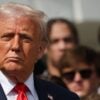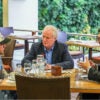As a world leader, the United States cannot be lackadaisical about the power of symbols and images. Ronald Reagan knew this and as one of his first official acts as president, he turned the lights back on the monuments in Washington, which had literally been darkened by President Carter during the energy crisis. One wonders what Reagan would have thought about the symbolism of the U.S. pavilion at the Shanghai World Expo, and – for that matter — about Secretary of State Hillary Clinton’s current visit to China in the name of the U.S.-China Strategic and Economic Dialogue, which proceeds today and tomorrow. Most likely, he would not have been impressed.
Somehow, the United States has ended up with the worst of two worlds, in public diplomacy terms. China is billing the Shanghai World Expo as the biggest World Expo ever – a public diplomacy extravaganza on par with the Beijing 2008 Olympics in its symbolic messaging. While the U.S. media has just about ignored this international event, China is stating that as many as 100 million visitors are expected between now and October 1. Less than a year ago, the United States did not even have plans for the construction of a pavilion, and no money was appropriated in the State Department budget for it.
The Daily Signal depends on the support of readers like you. Donate now
Unfortunately, this omission was not the result of a principled policy decision to protest Chinese human rights abuses. That would have been entirely justifiable, and it could, if properly explained, have made a powerful and principled public statement about American values to the world.
Rather, the U.S. absence seems to have been an oversight on the State Department’s part, which Hillary Clinton took upon herself to correct when she took office. Consequently, the U.S. pavilion came about through corporate sponsorship (nothing wrong with that).
Now, the concept of a public-private partnership for public diplomacy is one that has merit. The private sector is certainly more creative and usually far more efficient than the U.S. government. And it often has the means and the flexibility that the government lacks. Yet, in the absence of proper planning, thinking, and coordination, the result can backfire.
What is far more problematic is the evidence of hasty planning. As reported by The Washington Post the outcome looks something like a convention center in a mid-sized American city, a square, windowless construction that houses three movie theaters.
Worse is the absolute lack of a coherent public message to go with the US attendance at the World Expo. While the Obama administration is pursuing a dialogue with China that has confined any controversial mentions of human rights abuses to closed door meetings, the U.S. Secretary of State could this weekend be found in Shanghai connecting with Chinese children by handing out teddy bears. “It’s like a coming out party for countries and cities,” Clinton told reporters according to Reuters. “There is a real historical significance to them doing this.”
Yes, indeed, but what is the message when not only the teddy bears, but every item in the gift shop from the bison to the pink cowboy hats marked “Made in China”? Perhaps the “historical significance” being implied is not what Americans would want the world to understand about their great country, nor reflecting its real role in the world.






























